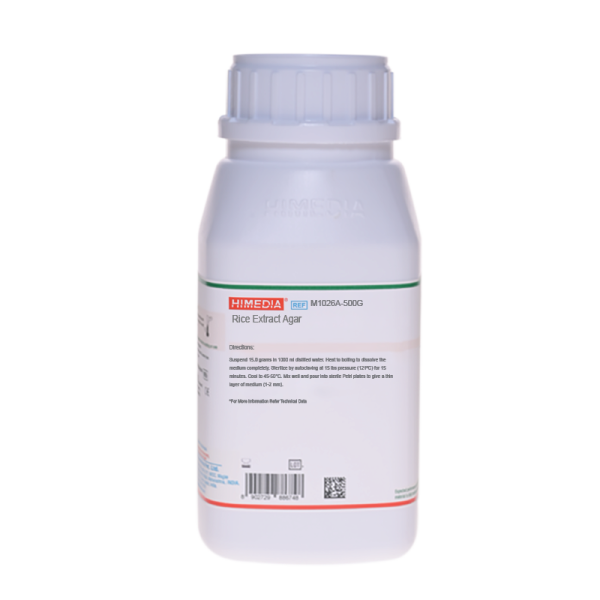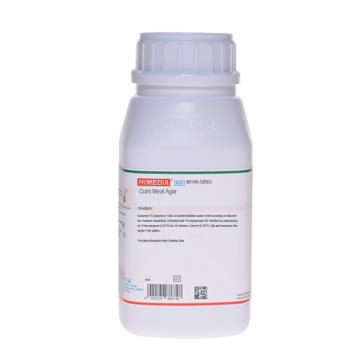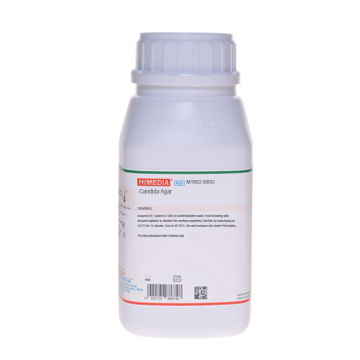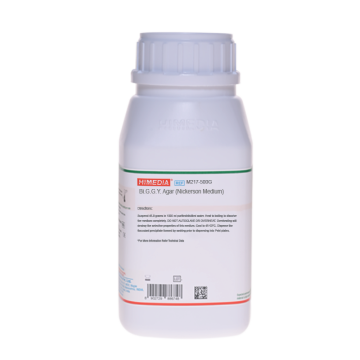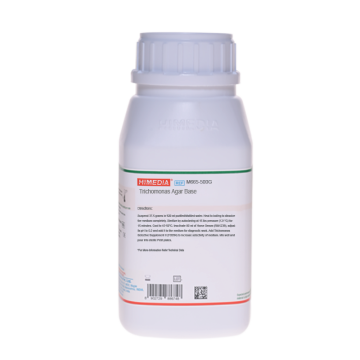 Your enquiry has been submitted
Your enquiry has been submitted
Rice Extract Agar
Rice Extract Agar is recommended for differentiation of yeasts by means of their typical chlamydospores and on basis of micromorphological criteria.
Composition**
| Ingredients | Gms / Litre |
|---|---|
| Rice extract, concentrated | 0.700 |
| Agar | 14.300 |
Final pH (at 25°C): 5.8±0.2
**Formula adjusted, standardized to suit performance parameters
Directions
Suspend 15.0 grams in 1000 ml distilled water. Heat to boiling to dissolve the medium completely. Sterilize by autoclaving at 15 lbs pressure (121°C) for 15 minutes. Mix well and pour into sterile Petri plates to give a thin layer of medium (1-2 mm).
Principle And Interpretation
Rice Extract Agar was developed by Taschdjian to aid in the identification of chlamydospore producing species of Candida (1).This medium can be used for culturing yeasts and differentiating them on basis of micromorphological characteristics particularly for differentiation of C.albicans and C. stellatoidea on basis of formation of chlamydospores. Rieth had demonstrated that this medium can be used for mycological diagnostic procedures (2). Rice extract in the medium serves as sole nutrient source. A small inoculum of suspected Candida colony can be inoculated by streaking (very thinly) on the surface of rice extract agar in 3-4 broad zig zag lines and covered with cover glass This oxygen deficient condition favours chlamydospore formation and pseudomycelial growth of yeasts. If the specimen is heavily infected with Candida it can be streaked directly on agar. On incubation for approximately 96 hours at 22-25°C culture can be directly examined under microscope through cover glass.
Culture may be confirmed further as suggested by Ajello et.al (3).Typical morphologies can be revealed as under:
| Fungal structures | Fungi |
|---|---|
| Chlamydospores (diameter 6-12 µm, thick, refractile cell wall with double contours), pseudomycelium, blastospores (diameter 3-6 µm) | C.albicans Very occasionally C. stellatoidea |
| Pseudomycelium, some times also true mycelium, usually blastospores. No chlamydospores | Other Candida species, |
| Arthrospores, blastospores, true mycelium, occasionally also pseudomycelium | Trichospore species |
| Blastospores, no chlamydospores, no pseudomycelium | Other yeast species |
| Ascospores in the asci | Perfect yeasts |
| Arthrospores, true mycelium, no blastospores | Geotrichium species |
Quality Control
Appearance Off-white to light yellow coloured homogeneous free flowing powder
Gelling Firm, comparable with 1.43% Agar gel.
Colour and Clarity of prepared medium White-light yellow coloured clear to slightly opalescent gel forms in Petri plates.
Reaction Reaction of 1.5% aqueous solution is pH 5.8 ± 0.2 at 25°C. pH : 5.8±0.2
pH 5.60-6.00
Cultural Response
M1026A: Cultural characteristics observed after an incubation of 96 hours at 22-25°C.
| Organism | Growth | Pseudomycelium | Chlamydospores |
|---|---|---|---|
| Candida albicans ATCC 10231 | Good-luxuriant | Positive reaction | Positive reaction |
| Candida stellatoidea | Good-luxuriant | Positive reaction | Negative reaction |
| Saccharomyces cerevesiae ATCC 7752 | Poor-fair | Negative reaction | Negative reaction |
Storage and Shelf Life
Store below 30°C in tightly closed container and the prepared medium at 2-8°C. Use before expiry date on the label.
Reference
- Taschdjian. 1953. Mycologia 45 : 474.
- Reith, H., Hansen,P. El-Fikl, A.Y., u ITO, K. Hefedifferenzierung auf Reisagar-Bill.Pharm.Res., Inst., (Osaka) 19; 13-(1959).
- Ajello, L., Georg,L.K., Kaplan,W.A., Kaufman, L. :Laboratory AManual for medical Mycology Communicable Disease Center, Atalanta, Georgia, USA, 1966.
| Product Name | Rice Extract Agar |
|---|---|
| SKU | M1026A |
| Product Type | Regular |
| Physical Form | Powder |
| Origin | Animal Free (Veg) |
| Packaging type | HDPE |
| References | 1. Kelly J. P. and Funigiello F., 1959, J. Lab. And Clin. Med., 53:807 |
| Customized Product Available | No |



